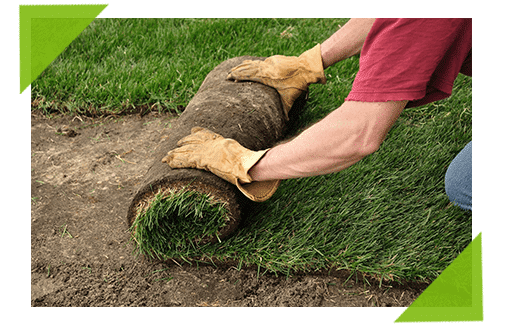What is Sod?
Sod is simply grass and a small part of the soil beneath it held together by the root system or in some cases by a thin layer of biodegradable material. But, that is only part of what sod is. There are other aspects that are interesting and worth looking at when exploring the many benefits of sod.

WHERE IS SOD USED?
Sod is most commonly used in the following places:
1. In lawns for private homes, business, and schools
2. Golf courses
3. Sports stadiums
What is sod used for?
- Landscaping is one of the fastest and easiest ways to increase the value of a home, but sod has many uses that go beyond appearance. For example:Sod is used to establish a lawn quickly especially in areas where seed would be too expensive to use or would simply blow away.
- On hillsides and new construction sites, sod can help prevent erosion.
- Sod can improve cooling.
- Sod can also improve air and water quality in the immediate area.
- It can help with the prevention of flooding in the area. Sod helps to drain the water and to divert it to the ground where it becomes part of the ground water supply instead of overflowing overtaxed drain systems or already swollen local water supplies.
- In Scandinavia, sod is often used as a roofing material. It is also used to build traditional houses in Iceland. In the early history of the western region of the United States, sod was used to build homes.
HOW IS SOD GROWN AND HARVESTED?
Like any other crop for sale, sod must be first grown and then harvested, transported to the consumer and then installed. The United States Department of Agriculture estimates that there are nearly 1,500 specialized, sod growing farms in the US, growing many varieties of sod on almost 370,000 acres of land. Because there are some restrictions to travel including expenses, most sod is grown and sold locally, but new strains and methods are being developed all of the time
Sod is planted
and then harvested sometime between 10 and 18 months later depending on the variety and how quickly it grows to the right size for harvest. The rate of growth also depends on the climate conditions of the farm and other factors such as the use of fertilizer and more.
Sod is harvested
and sold in several ways: either as a square slab, which is easier to handle for a private homeowner, a rolled rectangle, which is typically used for a new lawn installation, or in four foot wide rolls for major repair projects typically used in the bigger, commercial installations.
Currently,
Mississippi State University is working on a hydroponic (grown without soil) variety of sod that would be not only lighter, but would be able to travel greater distances without stress. This variety might be able to handle international shipping better than traditional types.
ARE THERE DIFFERENT TYPES OF SOD?
There are many different types of sod because different types of grass grow better under different conditions. Some have been specifically bred to handle conditions in an area, and some are just very adaptable to wherever they will grow. A few of these types include:
BERMUDA GRASS
Bermuda Grass is also includes the subspecies Celebration Bermuda Grass and Discovery Bermuda Grass. Celebration and Discovery are both darker green to dark blue-green in color, and are both tolerant of foot traffic and drought conditions. Both are used in the Southeastern part of the U.S. extensively.
Celebration has won several prizes and has been installed by the Tampa Bay Buccaneers in their football stadium. Discovery is an excellent choice for low maintenance because of its very slow growth. Unlike Celebration and Discovery, Bermuda Grass is adaptable to nearly all climates.
BELLA BLUEGRASS
This is the first of the bluegrass varieties that is sold only as sod. It is also considered a dwarf plant and needs very little mowing to keep it trimmed to the right height. Originally developed by the University of Nebraska, it is prized for states that are trying to conserve water because it is highly drought resistant and grows well even in poor soil conditions. Bella Bluegrass is also one of the few bluegrass types that grow well in the northern regions of the U.S.
ST. AUGUSTINE & CAPTIVE ST. AUGUSTINE
St. Augustine and Captive St. Augustine are both found in the warmer regions of the southern U.S. St. Augustine is also found in parts of Mexico, Australia, and Africa. It does not do well in the cold and is available as sod only. Captive St. Augustine was a recent development by the University of Florida, bred to be resistant to pests especially the chinch bug. It is also tolerant of shade conditions and grows slowly so it has minimum maintenance including less frequent mowing.
CENTIPEDE GRASS & COVINGTON
Centipede Grass and Covington were brought from Southeastern Asia in 1916 and is typically only found in the Florida region. It is a wider blade grass with a coarser appearance than others but is also considered to be lower maintenance. Unlike other grass types it will maintain its color later in the fall and turn green early in the spring.
Sod is one of the fastest ways to start and establish a lawn, and it is important to know the conditions that it will be growing under when choosing the type that you want.
You should look for a type that will grow well in the climate, tolerate the challenges that it will face in your lawn, and give you the appearance that you want. You should also consider maintenance needs when choosing the right sod for your project because lawn care is an on-going process.







